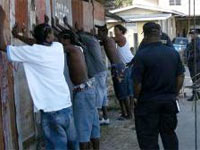
PORT OF SPAIN, Trinidad — An increasing crime rate is threatening economies and livelihoods in Caribbean countries, states a new United Nations report that calls for the right mix of policies and programmes to tackle the problem.
The Caribbean Human Development Report 2012, prepared by the UN Development Programme (UNDP), says that with the exception of Barbados and Suriname, homicide rates – including gang-related killings – have increased substantially in the last 12 years across the Caribbean, while they have been falling or stabilizing in other parts of the world.
Latin America and the Caribbean are home to 8.5 percent of the world population, yet the region accounts for some 27 percent of the world’s homicides, according to the report, which was launched on Wednesday in Port of Spain, Trinidad.
The report – the first UN Human Development Report focusing on the Caribbean – is the result of extensive consultations with 450 experts, practitioners and leaders and reflect a large-scale survey with 11,555 citizens in the seven assessed countries in region: Antigua and Barbuda, Barbados, Guyana, Jamaica, Saint Lucia, Suriname, and Trinidad and Tobago.
It found that even though the total number of murders in Jamaica dropped after the report’s completion to 1,124 in 2011 – a seven-year low – the country has the highest homicide rate in the Caribbean and the third-highest murder rate worldwide in recent years, with about 60 murders per 100,000 inhabitants.
Only El Salvador and Honduras have higher rates, with 66 and 82.1 murders respectively per 100,000 people, the report notes, citing figures from the UN Office on Drugs and Crime (UNODC). In Trinidad and Tobago, the report notes, murder rates increased five-fold over a decade, to more than 40 per 100,000 in 2008, and then declined to 36 in 2010.
“Violence limits people’s choices, threatens their physical integrity, and disrupts their daily lives,” said UNDP administrator Helen Clark at the report’s launch.
“This report stresses the need to rethink our approaches to tackling crime and violence and providing security on the ground,” said Clark. “We need to follow approaches that are centred on citizen security and address the causes of this recent increase in violent crime, including social, economic, and political exclusion.”
Although murder rates are exceedingly high by global standards, Caribbean nations can reverse the trend, states the report, which calls for governments to beef up public institutions to tackle crime and violence while boosting preventive measures.
Among its recommendations, the report calls on Caribbean governments to implement youth crime prevention through education, as well as provide job opportunities that target the marginalized urban poor.
Because crime harms social cohesion, Caribbean nations must better address youth violence and street gangs, whose crimes are rarely prosecuted, the report adds.
As for the impact on the region’s economies, estimates by the Caribbean Community (CARICOM) show that the cost of gang-related crime is between 2.8 percent and 4 percent of gross domestic product (GDP) in the region through both the cost of policing and as a result of lost income from youth incarceration and reduced tourism.
According to the report, crime costs Jamaica alone over $529 million a year in lost income. In Trinidad and Tobago, a one percent reduction in youth crime would boost tourism revenue by $35 million per year. For every additional “gang” in a community, homicide rates increased by about 10 percent, according to research featured in the report.
The Caribbean Human Development Report 2012 is available here.
Source: Caribbean News Now!


